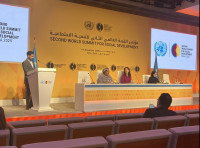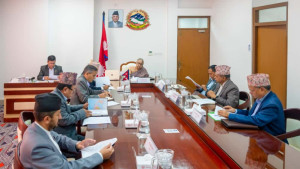Opinion
Running water
Nepal should reserve the right to use fresh water runoffs for irrigation while signing the PTA with India
Prakash Bom
South Asia supports a quarter of the world population and posesses one twentieth of the world’s annual renewable fresh water resources. The annual per capita of renewable fresh water resources in Nepal is 9,600 m3, whereas it is 1.2 m3 for India. This means, Nepal’s fresh water resources can be used for multiple purposes other than just generating hydropower. Therefore, the Agriculture and Water Resources Committee in Parliament must not pressurise the government to sign a Power Trade Agreement (PTA) with India in a hurry. The signing has been thankfully postponed for now and until that materialises, Nepal needs to scrupulously analyse the terms and conditions of the accord.
Plan to use
In most developed nations, 75 percent of renewable fresh water is used in agriculture—for irrigation and livestock—20 percent is used in industries and 5 percent for domestic purposes—drinking, cooking and sanitation. Whereas, in Nepal, only 10 percent of the total freshwater runoff is used in agriculture for irrigation. Nepal has yet to build canals for irrigation to commercialise agriculture, horticulture and livestock.
That is why the PTA with India must not restrict Nepal to constructing hydropower but also to develop agriculture and industries along the rivers. Unless the Government of Nepal develops a plan for the commercialisation of agriculture and builds water supply systems to support its population, its renewable fresh water resources will be of no use.
Political parties in Nepal have been prosposing an agenda to transform traditional agriculture into commercial farming for a long time now. Accordingly, the budget for the fiscal year 2014/15 has allocated funds for agricultural development. But if the parties and government planners both fail to act with urgency to develop systems to use renewable fresh water resources in agriculture, the funds could just go to waste. That is to say, in order to focus on commercial farming, horticulture, livestock and fisheries, Nepal must build canals for irrigation, fishery and transport, particularly along the Inner Tarai and other regions of the Tarai.
Canals for growth
The canals must run east or west, but not to the south, along the plains of the Chure hill bases. For instance, if canals are to be built with the runoffs of the Karnali river from Chisapani, one canal can be built to flow to the west and merge into the Mahakali river and another to the east, all the way to the Narayani. Similarly, a canal can be built from the runoffs of the Narayani river from the north of Narayanghat through Hetauda, Nijgad to the Koshi river, where water can flow towards both the east and the west. Such canals will provide ample opportunity to the private sector to commercialise farming with sufficient irrigation, provide water for fisheries, livestock, industries, transports and generate hydroelectricity all along the canals.
It should not be difficult to imagine building canals, as all developed countries also transformed their agriculture through commercial farming and became industrialised. In the US, New York state, for example, built a 336 mile (584 km) long Erie Canal from Lake Erie (one of the Great Lakes) to the Mohak River, which merged into the Hudson River in 1825. This commercialised New York’s farming with industries and water transports. Similarly, the Sutlej canal transformed India’s Punjab, Haryana and Rajasthan states. A canal, apart from supporting agriculture, also manages floods and acts as a water reservoir.
If the main political parties and government have the nerve and vision to build an east-west canal along the Inner Tarai and Tarai, they must reserve the right to use the waters of the Karnali, Gandak and Koshi to build such canals while signing the PTA with India. If they fail, Nepal will have difficulty commercialising agriculture and developing its industries. And even if India is unwilling to do so, then Nepal can build such canals on its own.
Funds from the people
If the Nepal government does not have the budget for it, it must come up with a policy to raise funds by introducing a Citizens’ Entitlement Law for huge national investments on a voluntary basis, which will yield pension and health care coverage to those who invest. For instance, if 10 million participants invest Rs 1,000 each month, $100 million will be collected in one month alone. If the government can convince the citizens of such a law, which can be guaranteed by the Central Bank, then they are likely to invest in this pursuit of building the nation.
Besides, Nepal is politically committed to federalism. This means that there will soon be constitutional processes to form federal states. Each federal state will have right to self-governance and self-autonomy. Therefore, while signing the PTA with India, it is imperative to reserve the right to use renewable fresh water runoffs along the proposed hydropower houses.
So it is crucial that the main political parties and the government be careful while signing the PTA with India, despite the calls of members of the Agriculture and Water Resources Commission and cross-party lawmakers to speed up the work just for the sake of hydropower. The government should ensure that it protects the national interest relating to the industrialisation of future federal states. If the PTA is not signed with that provision, it will not be a win-win deal with India.
Bom is associated with the Non-Resident Nepali Association, New York, the US




 17.12°C Kathmandu
17.12°C Kathmandu










